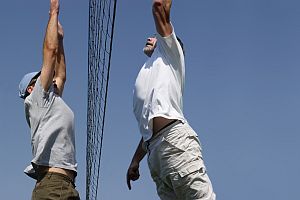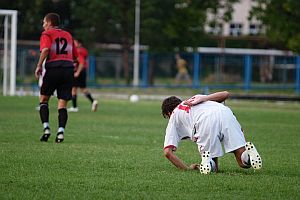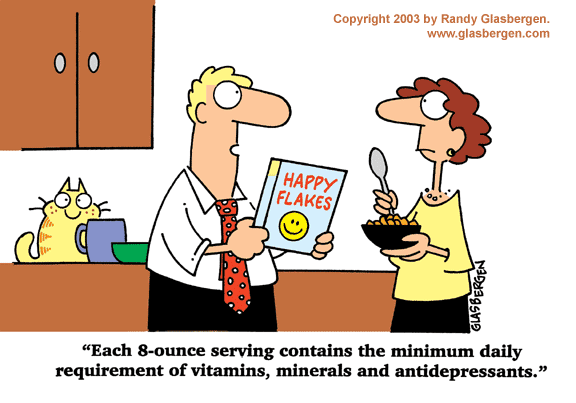“Exercise” Versus “Lifestyle Activity”: How Active Are You-Really?
 If you are like most people, working out just for the sake of working out does not really appeal (although there are many dedicated gym buffs who couldn’t live without their daily workouts!). We all know that it’s important to exercise regularly if we want to live a long and healthy life. However, if you find the idea of trotting along on a treadmill for 15 minutes and then spending half an hour of working out on Nautilus machines to be about as exciting as a trip to the dentist, then this article is for you!
If you are like most people, working out just for the sake of working out does not really appeal (although there are many dedicated gym buffs who couldn’t live without their daily workouts!). We all know that it’s important to exercise regularly if we want to live a long and healthy life. However, if you find the idea of trotting along on a treadmill for 15 minutes and then spending half an hour of working out on Nautilus machines to be about as exciting as a trip to the dentist, then this article is for you!
Experts recommend that we get at least 150 minutes of exercise each week to stay in shape. But many people find taking this much exercise at once (or in three 50-minute stretches) too daunting. The good news is that a recent study conducted by researchers at Boston University that was published in the journal Medicine & Science in Sports & Exercise found that bouts of exercise lasting less than 10 minutes a couple of times daily, such as the kind you get when cleaning the house, were sufficient to meet your weekly exercise needs.
Over 2,000 participants were included in the study, more than half of whom were overweight. Motion detectors were attached to each of the subjects for eight days, and an average of half the participants met their weekly exercise quota of 150 minutes. The average participant met his or her quota with exercise that lasted less than 10 minutes at a time. The types of exercise ranged from moderate (heavy cleaning, walking briskly and sports such as golf and badminton) to vigorous (running, hiking, shoveling and farm work).
As long as the participants met their 150-minute per week quota, no matter the length of their exercise, they had lower body mass index, smaller waists, lower triglycerides and better cholesterol levels than those who did not meet the quota. Assistant professor at Boston University’s School of Medicine, Nicole Glazer, says “But this study really speaks to the idea that some activity is better than nothing. Parking a little bit farther away, getting off the bus one stop early-all of these little things can add up and are related to a healthier profile.”
For years, researchers have studied the effects of exercise from practicing sports or visiting the gym. However, according to Glazer, “This idea of lifestyle activity is one that is under-measured in research studies.” Activities such as taking the stairs instead of the elevator, using a push mower instead of a riding mower, etc. can add up to a significant amount of energy expenditure. Experts still stress that it’s important to also get in some traditional forms of exercise and not merely replace it with lifestyle activity. Still, any exercise is useful.
“The levels of sedentary behavior in this country are alarming. So the concern that someone’s going to stop exercising and instead just get off the bus a stop earlier, that’s not my concern,” Glazer says. “The real concern is, is this a stepping-stone? Is this the way we can get inactive people to do any sort of activity? People will come up with any excuse to not exercise. I don’t need to worry about my giving them one. They’ll be able to think of something.”
Keys to Strengthening Your Immune System
 We are bombarded daily with all sorts of microbes that can cause illness. Interestingly, if we are exposed to a wide range of these microbes as children, studies have shown that we will have a lower risk of asthma and allergies as well as a stronger immune system. There are a number of factors that influence the health of our immune system, including diet, stress, exercise and aging. Following are some strategies you can use to help strengthen your immune system.
We are bombarded daily with all sorts of microbes that can cause illness. Interestingly, if we are exposed to a wide range of these microbes as children, studies have shown that we will have a lower risk of asthma and allergies as well as a stronger immune system. There are a number of factors that influence the health of our immune system, including diet, stress, exercise and aging. Following are some strategies you can use to help strengthen your immune system.
Eat plenty of fruits and vegetables – These are high in the vitamins, minerals and trace elements you need to help keep you healthy, particularly those high in vitamin C (red bell peppers, strawberries, broccoli, citrus fruits) and zinc (nuts, seeds, wheat germ).
Reduce stress – Chronic stress has been shown to inhibit the production of interleukins and cytokines, which are responsible for stimulating the action of white blood cells. Chronic stress also causes the stress hormone cortisol to be continually released into the bloodstream, which in the long term suppresses the production of pathogen-fighting T cells and antibodies.
Get out in the sun/Make sure you get enough Vitamin D – Insufficient vitamin D has been linked to greater susceptibility to infection. Approximately one out of three Americans is deficient in vitamin D. Try to get out in the sun in the summer months wearing minimal clothing and no sunscreen for 5 to 10 minutes two or three times a week between the hours of 10 am and 3 pm. This will provide you with sufficient vitamin D without increasing your risk of skin cancer. You can also take a supplement in the winter months or if you live in a place without much sun.
Get sufficient sleep – Sleep deprivation increases inflammation and inhibits the immune response. One study found that people who habitually slept less than seven hours each night were nearly three times more likely to catch a cold than people who slept eight hours or more.
Exercise – Moderate exercise has been shown to decrease stress and boost the immune system. Thirty minutes of moderate exercise each day, such as a brisk walk, raises the body’s levels of leukocytes, which are cells that help guard against infection.
Eat probiotics – Perhaps even more important than antibiotics in the fight against infection are probiotics, beneficial bacteria that live in the gut and upper respiratory tract. They boost the immune system by encouraging the production of certain T cells. You can find probiotics in yogurt, sauerkraut and kimchi, or you can take a probiotic supplement.
Avoid sugar – Even 100 grams of sugar, the equivalent of a 24-oz soda, depresses your immune system by reducing the ability of white blood cells to combat bacteria. This effect can last for a few hours after sugar ingestion, so if you are trying to stay healthy, keep away from the sweets!
How Chiropractic Care Has Helped Me: Introducing Allison Jones
 Competitive cycling is a sport that taxes the body in a major way. Competitions often last for days, with little time in between courses to recover. Skiing is another competitive sport that requires large amounts of endurance. Now imagine competing in these sports using only one leg! Allison Jones was born with a deformed femur and wears a prosthetic leg, but it has not stopped her from becoming one of the top female athletes in these two fields. Jones has competed in six Paralympic Games and won over a dozen medals in both in cycling and skiing, and she continues to leave her competitors in the dust.
Competitive cycling is a sport that taxes the body in a major way. Competitions often last for days, with little time in between courses to recover. Skiing is another competitive sport that requires large amounts of endurance. Now imagine competing in these sports using only one leg! Allison Jones was born with a deformed femur and wears a prosthetic leg, but it has not stopped her from becoming one of the top female athletes in these two fields. Jones has competed in six Paralympic Games and won over a dozen medals in both in cycling and skiing, and she continues to leave her competitors in the dust.
“My parents started me skiing when I was five years old … by age six I was cycling around the neighborhood with all my friends,” Jones said. Her parents made sure that her lack of a limb did not get in the way of her being a kid. “This could have set me up for a life of lower expectations and lower activity levels but not with my parents. My mother and father were very active and I was to take part in everything. I learned to ride a bike, skate board, rock climb, white water raft, hike, ski, and to just be a kid. I only knew to be a kid and not someone with a disability.”
Jones is a strong believer in the benefits of chiropractic care. She said, “I was born without my right leg, and have met life’s challenges with the attitude that quitting is not an option. Chiropractic care has been essential to my good health and success – including earning multiple gold medals in international competitions over the past 10 years.”
Jones credits her chiropractor, Dr. Mindy Mar, with helping her to achieve the most her body can accomplish. Mar says, “Professional athletes have the same issues as everyone else when it comes to stress, aches, pains, lack of mobility – it’s just much more pronounced. Chiropractic care allows everyone to live their lives to the fullest.”
According to Jones, “I always push my body to the limit. The precise muscle releasing techniques and joint alignment that chiropractic care provides allows me to race day after day at peak performance.”
In 2011, Jones was nominated by ESPN for an Excellence in Sports Performance Yearly award (ESPY) for the best female athlete with a physical disability. During the Olympic Games in Beijing, she was the only American to have competed in both the summer and winter Olympics. She is currently training for the 2014 Winter Paralympics in Sochi, Russia. As Jones says, “Anything is possible if you put your mind to it.”
Building Eye-Hand Coordination
 We first begin to learn eye-hand coordination (sometimes also called hand-eye coordination) when we are infants, with the greatest amount of development occurring during childhood. But it is never too late to improve eye-hand coordination skills. It is important to maintain this function as we age, since it is central to so many of our daily tasks, such as driving or chopping vegetables.
We first begin to learn eye-hand coordination (sometimes also called hand-eye coordination) when we are infants, with the greatest amount of development occurring during childhood. But it is never too late to improve eye-hand coordination skills. It is important to maintain this function as we age, since it is central to so many of our daily tasks, such as driving or chopping vegetables.
According to a study published in the journal Communication Research, playing video games for as little as 20 minutes can improve your eye-hand coordination. Researchers found that college students who played video games for 20 minutes using a special controller demonstrated nearly twice the accuracy in shooting at a real target as the students who did not play the video game first.
Improved eye-hand coordination can help when fast reaction times are needed, such as when driving a car or playing with children. It can increase productivity at work and is useful for leisure activities as well, such as reading music and computer gaming. Following are a few activities that you can practice that will allow you to improve your eye-hand coordination.
Play video games – Either online or using a console like a Wii, playing video games that require a sensitive touch and precise timing has been shown to improve accuracy skills.
Do some coloring – Grab some markers or crayons and a coloring book and color away. Our hands are beginning to lose their fine motor coordination abilities now that more and more of us use a keyboard to write. Coloring will help to preserve those fine motor skills.
Play a racquet sport – Any sport involving a racquet and ball will help to improve your eye-hand coordination, in addition to it being a great aerobic workout! You have to react quickly to your opponent’s moves and quickly judge where they will hit the ball.
Take up juggling – Start juggling two balls from hand to hand, then gradually introduce a third (and even a fourth if you can manage it). It will improve both coordination and focus.
Do a jigsaw puzzle – Useful for improving both eye-hand coordination and reasoning, a jigsaw puzzle is a fun way to hone these skills, particularly if it is a 3D puzzle.
Play catch – A great activity that can help improve both your and your child’s hand-eye accuracy, a simple game of catch using a tennis ball or other type of small ball is a great way of sharpening your skills while spending time with your kids.
Create something – Doing crafts such as model building and knitting can be creative ways of improving your eye-hand coordination, and you’ll have something to show for it to boot!
Tips for Working on Your Feet All Day
 Quite a few jobs require you to be on your feet all day. Cashiers, flight attendants, nurses, restaurant workers and retail salespeople-to name just a few-must spend long hours on their feet with little time for a break. This can cause a range of problems, including low back pain, knee pain, plantar fasciitis, sore feet, swollen ankles and bunions. Following are a few tips to help keep you comfortable while you are on your feet.
Quite a few jobs require you to be on your feet all day. Cashiers, flight attendants, nurses, restaurant workers and retail salespeople-to name just a few-must spend long hours on their feet with little time for a break. This can cause a range of problems, including low back pain, knee pain, plantar fasciitis, sore feet, swollen ankles and bunions. Following are a few tips to help keep you comfortable while you are on your feet.
Wear good, sturdy shoes – Not every profession allows for comfy athletic shoes to be worn, but you can still buy shoes that look professional, are sturdy and fit well. Avoid shoes that have narrow toes and high heels. A one- or two-inch heel should be the maximum. Some shoe companies specialize in shoes made for comfort that absorb shock and provide adequate arch support. Your shoes should be neither too large nor too small for your feet, but err on the side of slightly larger if you are in doubt, since feet tend to swell the longer you stand. You should also change the shoes you wear every other day so pressure is put on slightly different areas of your feet each day.
Consider using insoles, arch supports or special orthotics – Figure these into the size of the shoes you buy. In fact, take your insoles or orthotics with you when shopping for shoes to be sure the shoes fit well with them inserted. A properly supported foot will help correct problems such as overpronation (the foot rolling inwards) or flat feet (lack of sufficient arches) that contribute to pain in the feet, knees, hips and lower back.
Choose your socks carefully – Choose socks that will wick moisture from your feet. You can also find socks that are specifically made to reduce friction, with extra cushioning at the heel and ball of the foot. If you can, wear compression socks that go all the way to the knee. The light compression these socks provide can help reduce swelling in your lower legs.
Soften the floor surface if possible – If you tend to stand in a fixed spot every day, bring in a small carpet or padded mat to stand on. Any kind of softer surface you can put between your feet and concrete floors will help to reduce the impact on your feet.
Do simple leg exercises – From time to time, rise up and down on the balls of your feet to help increase the circulation in your lower legs. Another good move is to stretch your calf muscles. Lunge forward with one leg while keeping the heel of the other flat on the floor. This will help keep your calf muscles from becoming too tight, which increases your risk of plantar fasciitis.
What’s the Difference Between an MD and a DC?
 It’s important to know the basic differences between an MD (Medical Doctor) and a DC (Doctor of Chiropractic) so that you understand the unique role that each type of medical professional plays in helping you to maintain or regain your health.
It’s important to know the basic differences between an MD (Medical Doctor) and a DC (Doctor of Chiropractic) so that you understand the unique role that each type of medical professional plays in helping you to maintain or regain your health.
MDs and DCs are both licensed healthcare providers. They examine, diagnose and treat patients. However, most MDs have more hours of training in physiology, whereas DCs typically have more hours of anatomy training. Their methods of practice may help explain this difference in emphasis. DCs are experts in musculoskeletal health and general wellness. Like an MD, a DC will use diagnostic imaging, lab tests, clinical exams and questionnaires to determine a diagnosis, but the course of treatment will be different. MDs tend to prescribe pharmaceuticals and surgery to treat patients, whereas DCs use a more holistic approach involving a variety of hands-on treatments as well as advice on diet and exercise.
Office visits are also often quite different experiences. On a typical visit to an MD, you will likely be asked by a nurse or assistant to fill out paperwork and provide information about your condition. Then the MD will visit you, look at the information, perhaps perform a brief clinical examination, and quickly prescribe a treatment. In the course of doing this, most doctors will take only a small amount of time to understand your overall health picture. And treatment will usually involve drugs and/or medical procedures.
It is not uncommon for patients to have a more personal relationship with their DC than with their MD. Visits to a DC also tend to be more involved. The chiropractor will speak with you at length about not only your physical symptoms, but your lifestyle habits as well. He or she will examine you, perform any necessary tests, discuss possible treatment options, and provide appropriate manual therapies. Together, these treatment methods are sometimes referred to as “physical medicine”. These may include targeted spinal adjustments, therapeutic massage, disc decompression, laser therapy, electrical stimulation and hot and cold treatments as well as structured exercise and stretching programs. In addition, the chiropractor may also make specific suggestions about your nutrition, day-to-day environment and physical activity.
In general, musculoskeletal problems (particularly those related to back, neck and joint pain) are better treated by a DC. However, many chiropractors have also developed specialized expertise in other areas as well. DCs will refer you to an MD if they believe that diagnosing and treating your specific condition is beyond their scope of practice.
A Reason to Smile!
Chiropractic and Professional Soccer
 Professional soccer (or football, as it is called in parts of the world outside the U.S.) is a sport that is rough on the musculoskeletal system. It’s not uncommon to see a player suddenly drop to the ground holding his leg in apparent pain. Sometimes this is just a way of slowing down the game or trying to draw a penalty. However, it can also be a sign that the player has sustained a real injury.
Professional soccer (or football, as it is called in parts of the world outside the U.S.) is a sport that is rough on the musculoskeletal system. It’s not uncommon to see a player suddenly drop to the ground holding his leg in apparent pain. Sometimes this is just a way of slowing down the game or trying to draw a penalty. However, it can also be a sign that the player has sustained a real injury.
Soccer involves movements that are particularly hard on the lower body. Players must often change direction very suddenly when running down the field. This means that they twist the upper body quickly in one direction while their feet are still planted in another. When this occurs, it places a great deal of stress on the tendons and ligaments in the knees, potentially resulting in injuries. Leg injuries can also occur when players are kicked repeatedly or are shoved or tackled when in vulnerable or awkward positions.
The legs aren’t the only part of a soccer player’s body that takes a beating. Their heads are often used to redirect a ball flying through the air at 60 or 70 mph, putting a strain on the entire spinal column. With all the twisting that soccer players do, it is easy for their spines to become misaligned, putting pressure on nerves and causing pain not only in the back, but in the limbs as well.
With all this abuse, many professional soccer players have found that chiropractic care helps keep them on the field and performing at their best. Dr. Mike Foudy, who was the team chiropractor for the Women’s World Cup Championship team said, “all but one member of the team received regular chiropractic care during their training and on the days of their matches. Chiropractic adjustments balanced their spine, removed nerve pressure and optimized the function of their bodies. All the players felt like they healed quicker from injuries and that the care gave them a competitive edge.”
A former World Cup champion from Brazil, Carlos Alberto Torres, credits chiropractic with resolving chronic disabling back pain that had kept him relying on crutches to walk. Traditional medical treatments had not helped, and finally someone referred him to a chiropractor. The chiropractic care he received enabled him to have a quick and full recovery so he could walk again without crutches and free of pain.
With the 2014 FIFA World Cup coming up in Brazil, professional soccer players will no doubt be lining up for chiropractic services. As Dr. Erik Plasker, the team chiropractor for one of the top US youth soccer teams noted, “while the other teams are scrambling to change their lineups due to injuries, our team bounces back fast and brings an energetic advantage to championship games. The players and coach agree that chiropractic care helps them compete at the highest level and avoid injuries.”
The Benefits of Phosphorus
 Our need for phosphorus is almost as great as our need for calcium. In fact, phosphorus is the second-most abundant mineral in the human body after calcium, so it’s no wonder that it has a major part to play in achieving good health. It works with calcium to ensure strong bones and teeth, helps the kidneys to filter waste products, and plays a key role in how the body uses and stores its energy. On top of all that, phosphorus is also necessary for the production of DNA and RNA, and is needed to produce, maintain and repair our body’s cells.
Our need for phosphorus is almost as great as our need for calcium. In fact, phosphorus is the second-most abundant mineral in the human body after calcium, so it’s no wonder that it has a major part to play in achieving good health. It works with calcium to ensure strong bones and teeth, helps the kidneys to filter waste products, and plays a key role in how the body uses and stores its energy. On top of all that, phosphorus is also necessary for the production of DNA and RNA, and is needed to produce, maintain and repair our body’s cells.
Even though phosphorus is as important to maintaining healthy bones and teeth as calcium, we do not hear as much about its importance in our diet as we do about calcium. This is likely because most people get enough phosphorus from their diet. In fact, some get more than is necessary (particularly if they’re not getting enough calcium), which can cause a number of health problems. Too much phosphorus in relation to calcium can lead to an increase in your risk of cardiovascular disease. The greater your phosphorus intake, the more calcium you need.
The daily recommended intake for phosphorus is as follows:
Babies 0 to 6 months: 100 mg/day
Babies 7 to 12 months: 275 mg/day
Children 1 to 3 years: 460 mg/day
Children 4 to 8 years: 500 mg/day
Adolescents 9 to 18 years: 1,250 mg/day
Adults: 700 mg/day
Conditions such as diabetes, malnutrition and alcoholism can increase a person’s risk of phosphorus deficiency. This can also be a problem for those who have conditions that create problems with absorption, such as celiac disease and Crohn’s disease. Symptoms of phosphorus deficiency may include weak bones, stiff joints, fatigue, anxiety, loss of appetite, bone pain, irritability and irregular breathing.
Foods high in protein have the greatest amount of phosphorus. Meat and dairy products, as well as nuts, eggs and legumes are good sources of phosphorus in the diet. It can also be found in whole grains and dried fruits. You generally do not have to worry about not getting enough phosphorus in your diet, as it is so prevalent in most of the things we eat. For example, one three-ounce serving of meat contains between 150 mg and 250 mg of phosphorus. What is more important is that you get a sufficient amount of calcium so that it will balance out any excess phosphorus in you get from your diet so that it does not lead to adverse health issues.

